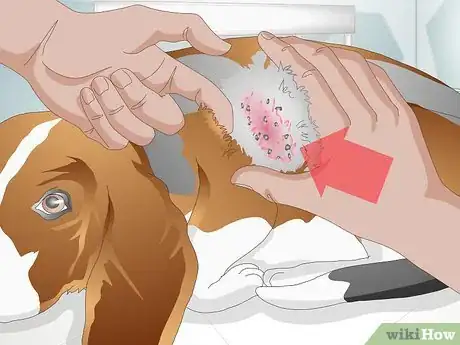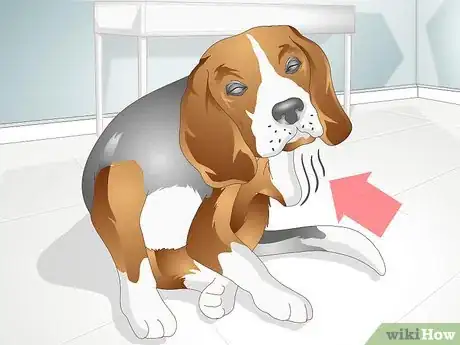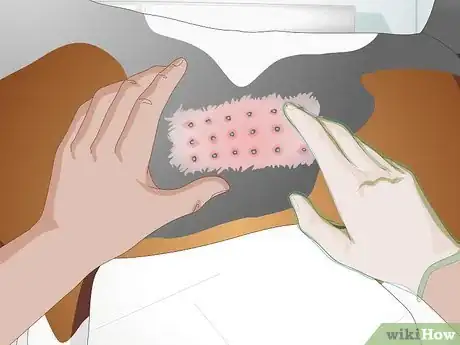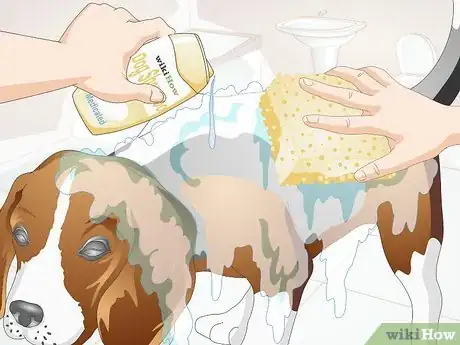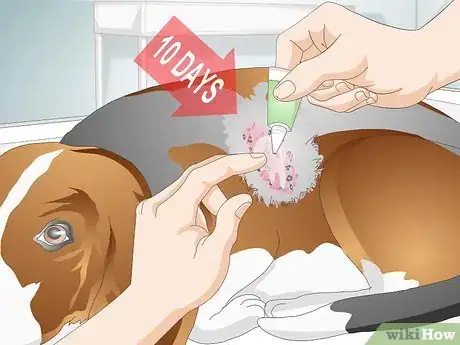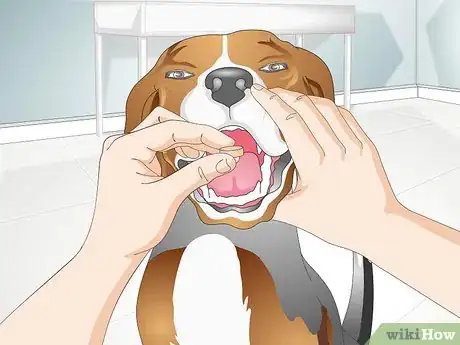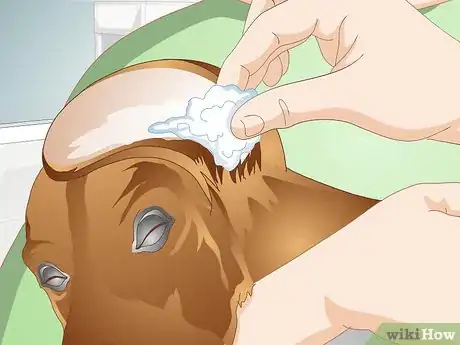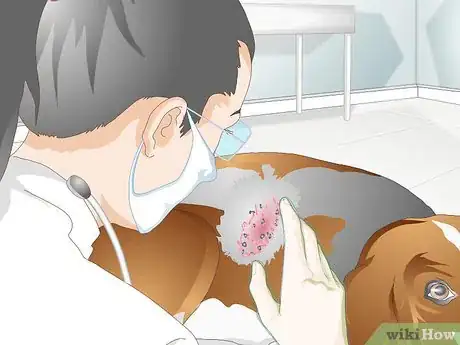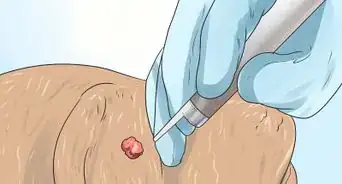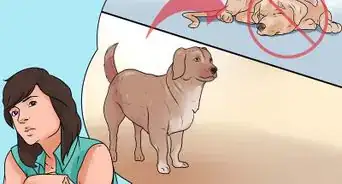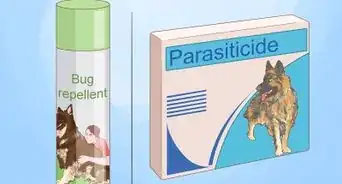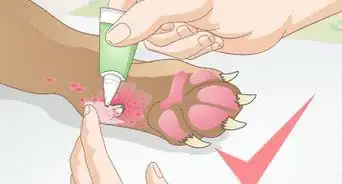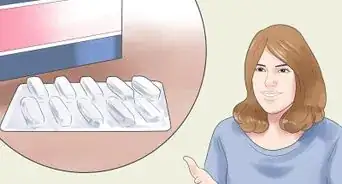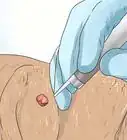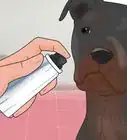This article was co-authored by Stephanie Abrams, DVM, MS, DACVD. Dr. Stephanie Abrams is a Board Certified Veterinary Dermatologist with over eight years of veterinary experience. She specializes in treating skin conditions in cats and dogs. Dr. Abrams earned a BA from Skidmore College and a DVM from Ross University School of Veterinary Medicine. After earning her DVM, she completed an internship at Tufts Veterinary Emergency Treatment & Specialties, followed by a residency in Dermatology at the Ohio State University School of Veterinary Medicine.
There are 8 references cited in this article, which can be found at the bottom of the page.
wikiHow marks an article as reader-approved once it receives enough positive feedback. In this case, 100% of readers who voted found the article helpful, earning it our reader-approved status.
This article has been viewed 83,393 times.
A yeast infection of the skin, also called “yeast dermatitis,” is a common skin concern for many dogs. It occurs when a specific type of yeast (called “Malassezia”) is overproduced. Certain breeds of dog are more susceptible to this problem, but all dogs are at risk.[1] It is important to quickly eliminate a skin yeast infection. These infections are often very uncomfortable for your pet. The dog’s constant scratching and chewing at their own skin can also lead to secondary infections.
Steps
Diagnosing a Yeast Skin Infection in your Dog
-
1Look closely at irritated skin. This will help you identify the problem as a yeast infection. Dogs with a skin yeast infection will scratch relentlessly, so patches of hair loss and weepy, sticky skin within those patches is common. Look for:
- Scaly skin.
- Reddening or blackening of the skin.
- Loss of hair in the afflicted area.
- Strong odor coming from the skin.
-
2Watch for the behavioral symptoms of yeast skin infection. In addition to showing specific dermatological symptoms, your dog may also exhibit strange behaviors; these are often caused by Malassezia. Look for these symptoms:[2]
- Constant itching and scratching.
- Shaking or tilting of the head (if the infection is on your dog’s skin or ears).
- Loss of balance or hearing (if the infection is on your dog’s skin or ears).
- Frequent walking around in circles (if the infection is on your dog’s skin or ears).
Advertisement -
3Make sure your dog is not experiencing skin allergies. The symptoms of a skin allergy and a yeast skin infection can appear similar: both involve your dog frequently scratching, dry skin, etc.
- The easiest way to rule out an allergy is to have your vet administer an allergy test to your dog.
- If you have recently switched your dog’s food or shampoo, this could be causing an allergic reaction. Try switching back to the previous food or shampoo and, if the symptoms disappear, you’ll know that your dog did not have Malassezia.
-
4Give a list of your dog’s symptoms to your veterinarian. Because yeast infection can be mistaken for other health problems (such as skin allergies), it’s important to have your veterinarian’s opinion. Keep a list of all of your dog’s skin symptoms to give to your vet.[3]
- Your vet may want to have a full medical history of your dog on file.
- With this information in hand, your vet can conduct medical testing on your dog, including urine, blood, and skin analysis.
Treating your Dog’s Yeast Skin Infection
-
1Wash your dog with medicated shampoo. Shampoo treatment is often all that is needed to get a yeast infection under control.[4] These shampoos are very common; you should be able to find medicated pet shampoos at any pet store or vet’s office. As long as there is no secondary infection present, follow these steps:
- Bathe your dog in an antifungal shampoo. The shampoo should contain the ingredients chlorhexidine, miconazole, or ketoconazole.[5] Know that not every medicated shampoo contains these anti yeast ingredients.
- When bathing your dog, make sure that the shampoo is on its skin for a full 10 minutes before you rinse it off.
- For full effectivity, give medicated baths for every 3-5 days, for 2-12 weeks (as long as symptoms last).
-
2Apply a topical cream. If your dog’s yeast skin infection is in a small area, you can apply a medical cream directly to the fungal infection. You should be able to purchase an antifungal topical cream from your veterinarian’s office, or from a pet-supply store.
- Apply a miconazole yeast infection cream to the affected areas a couple of times each day for 7-10 days.
- Only apply enough of the cream to thoroughly cover the infected area. The cream packaging will likely include instructions for applying the cream to your dog’s skin—follow these instructions closely.
-
3Give your dog an oral treatment. In cases where the yeast skin infection is chronic or does not respond to topical-cream treatment, you may need to administer an oral treatment. Oral treatments are typically an anti-fungal medication prescribed by your veterinarian.[6]
- Oral medications often include prescriptions which contain ketoconazole, fluconazole, or itraconazole.[7]
- These medications often need to be administered for a long period of time: from 5 weeks to several months.[8]
- Oral antifungal medications can have unpleasant side effects. These can affect your dog’s liver and may need to be monitored by your vet.
-
4Clean your dog’s ears. Ears are one of the most common locations for yeast skin infections, and it’s important to keep your dog’s ears clear and disinfected.[9]
- Dog ear-cleaning solutions are not given by prescription. There are many retail brands available; check your local pet store or vet’s office. There are also home-made recipes online—most of these use safe substances (such as apple cider vinegar).
- Apply an ear cleaner designed to lower pH levels, clean the ear gently with a soft tissue, and apply yeast infection cream inside the ear as directed.
- If the yeast infection is deeper in your dog’s middle ear, it will need to be treated with oral medication, and perhaps even with surgery.
- Serious yeast ear infections can take up to six weeks to heal.[10]
-
5See a vet if the yeast skin infection continues. If your pet’s yeast skin infection worsens or is not better at the end of either topical-cream or oral treatment, contact your veterinarian. Plan ahead to ask your vet questions, such as:
- “Is there anything I can do to keep my dog from scratching the infected area?”
- “What’s the best way to figure out if my dog has an allergy that caused this infection?”
- “Is it likely that this disease is congenital (present from birth) or genetic?”
Preventing Future Yeast Skin Infections
-
1Avoid common causes of yeast skin infections. Although these infections are, to some degree, unpredictable, there are certain common stressors that may prompt Malassezia yeast to grow abnormally.[11] These stressors include:
- Excess heat and humidity (keep your dog indoors during these conditions). Skin folds also tend to gather more humidity and can lead to an infection.
- Food and flea allergies.
-
2Know your dog’s breed. Certain breeds of dog are more susceptible to yeast skin infections, often due to their excess skin folds.[12] Breeds such as pugs and bulldogs fall into this category. Other breeds that are genetically predisposed towards Malassezia infections are:[13]
- Poodles and basset hounds,
- Cocker spaniels,
- Dachshunds.
-
3Keep your dog healthy. Malassezia yeast is commonly present on your dog’s skin, but usually only becomes pathogenic and causes harmful inflammation when your dog’s immune system is already compromised.[14]
- Keep your dog up to date on all of their immunizations.
- Check your dog for any injuries or cuts after she has spent time outside. These can become infected.
Expert Q&A
-
QuestionHow did my dog get a yeast infection on his skin?
 Stephanie Abrams, DVM, MS, DACVDDr. Stephanie Abrams is a Board Certified Veterinary Dermatologist with over eight years of veterinary experience. She specializes in treating skin conditions in cats and dogs. Dr. Abrams earned a BA from Skidmore College and a DVM from Ross University School of Veterinary Medicine. After earning her DVM, she completed an internship at Tufts Veterinary Emergency Treatment & Specialties, followed by a residency in Dermatology at the Ohio State University School of Veterinary Medicine.
Stephanie Abrams, DVM, MS, DACVDDr. Stephanie Abrams is a Board Certified Veterinary Dermatologist with over eight years of veterinary experience. She specializes in treating skin conditions in cats and dogs. Dr. Abrams earned a BA from Skidmore College and a DVM from Ross University School of Veterinary Medicine. After earning her DVM, she completed an internship at Tufts Veterinary Emergency Treatment & Specialties, followed by a residency in Dermatology at the Ohio State University School of Veterinary Medicine.
Board Certified Veterinary Dermatologist Although many people believe that it's caused by diet, the problem usually arises when there's a disruption in the skin barrier, where an overgrowth of yeast happens, especially if the area's moist. It's typically not because they eat a high green or high carbohydrate diet.
Although many people believe that it's caused by diet, the problem usually arises when there's a disruption in the skin barrier, where an overgrowth of yeast happens, especially if the area's moist. It's typically not because they eat a high green or high carbohydrate diet.
References
- ↑ http://www.peteducation.com/article.cfm?c=2+2102&aid=321
- ↑ http://pets.webmd.com/dogs/yeast-infection-in-dogs-causes-treatment-and-prevention?page=2
- ↑ http://www.petmd.com/dog/conditions/skin/c_dg_malassezia_dermatitis#
- ↑ http://www.vcahospitals.com/main/pet-health-information/article/animal-health/yeast-dermatitis-in-dogs/897
- ↑ http://www.vcahospitals.com/main/pet-health-information/article/animal-health/yeast-dermatitis-in-dogs/897
- ↑ http://www.vcahospitals.com/main/pet-health-information/article/animal-health/yeast-dermatitis-in-dogs/897
- ↑ http://www.peteducation.com/article.cfm?c=2+2102&aid=321
- ↑ http://www.peteducation.com/article.cfm?c=2+2102&aid=321
- ↑ http://pets.webmd.com/dogs/yeast-infection-in-dogs-causes-treatment-and-prevention
- ↑ http://pets.webmd.com/dogs/yeast-infection-in-dogs-causes-treatment-and-prevention?page=2
- ↑ http://www.petmd.com/dog/conditions/skin/c_dg_malassezia_dermatitis#
- ↑ http://www.1800petmeds.com/education/treating-pet-yeast-infections-51.htm
- ↑ http://www.petmd.com/dog/conditions/skin/c_dg_malassezia_dermatitis#
- ↑ http://www.1800petmeds.com/education/treating-pet-yeast-infections-51.htm
- ↑ http://www.1800petmeds.com/education/treating-pet-yeast-infections-51.htm
- ↑ http://www.vcahospitals.com/main/pet-health-information/article/animal-health/yeast-dermatitis-in-dogs/897
About This Article
If your dog has a yeast infection on its skin, you can treat it with a medicated shampoo. Bathe the dog, generously applying an antifungal shampoo. Let the shampoo sit on the dog’s skin for a full 10 minutes, then rinse it away thoroughly. Repeat this every 3-5 days for up to 12 weeks, or as long as the symptoms last. If the infection only covers a small area, you may be able to treat it by applying a medicated cream to the area instead of having to bathe the whole dog. If that doesn’t work, the dog may need to take oral medication. Keep reading for tips from our Veterinary co-author on how to diagnose a yeast skin infection!
